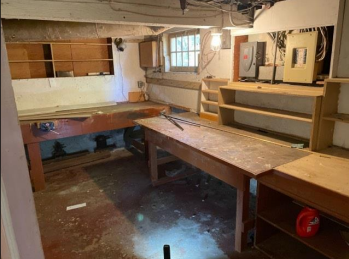- Photo: 70 year old house with headroom in basement under 7 ft may be a fatal flaw to some buyers.
- Abstract: Old house criteria to consider when deciding to renovate or demolish and build new.
Today, we delve into a topic that many homeowners face: the decision to renovate an old house or demolish it and build anew. It’s essential to evaluate the milestones of your home, considering factors beyond its age. While plumbing, HVAC, electrical, insulation, and interior finishes are expected to be replaced, let’s focus on the critical areas that can make or break your decision: the exterior, structural integrity, roof, attic, crawlspace or basement.
Exterior Assessment:
- Begin your evaluation by inspecting the exterior of your home. Look for signs of water damage, rot, or decay in the siding, windows, and doors. If these issues are widespread, it might be an indication of deeper structural problems.
- In many cases there is hidden moisture penetration wall damage that only becomes apparent when demolition exposes the interior spaces. Any renovation budget should always include a healthy contingency fund for these surprises.
Structural Integrity:
- Hire a qualified home inspector to assess the foundation and overall structural integrity of your home. Cracks in the foundation, sagging floors, or warped walls can be indicators of severe issues. If these problems are extensive and compromise the safety of the structure, a new build might be the safer option.
- Settlement of footings, cracked or leaning foundations, failed retaining walls, flowing ground water are all indicative of major soil issues and may be a fatal flaw.
Roof Condition:
- Evaluate the condition of your roof. If your roof has multiple layers of shingles, extensive damage, sagging or is reaching the end of its lifespan, it might be more cost-effective to start fresh with a new roof on a new structure. A solid roof is crucial to protecting your investment and maintaining a comfortable living environment.
- Faulty or clogged gutters and integral gutters can lead to widespread perimeter damage to the perimeter of the roof. Years of ice dams forming in winter can also severely damage the roof.
Attic Inspection:
- Check the attic for signs of water damage, mold, or pest infestations. Issues in the attic can affect the entire home and may require extensive remediation. If the problems are severe, it might be more practical to build a new home with a well-protected attic space.
- Older attics may suffer from the combined effects of high moisture levels and poor ventilation. If this is severe, rot may be extensive to the roof sheathing.
Crawlspace or Basement Issues:
- Inspect the crawlspace or basement for water intrusion, foundation cracks, and structural issues. A damp or unstable foundation can lead to a host of problems, impacting the entire structure. In such cases, rebuilding might be the only viable option.
- A real fatal flaw will be low headroom in the basement. Many older houses were never designed for occupancy, rather they were meant for dry storage.
Conclusion:
We hope this post assists you in making a well-informed decision about your old house. While sentimental value and historical significance may tug at your heartstrings, safety and practicality should be paramount in your considerations. A thorough evaluation of the exterior, structural integrity, roof, attic, crawlspace, or basement can help you decide whether to embark on a renovation journey or start anew with a fresh build. Happy decision-making, and here’s to many more years of enjoyable homeownership!

